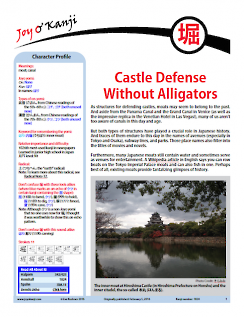堀
moat; canal
Kanji 1824
moat; canal
Thank you for visiting this Character Home Page. Below you'll find a synopsis of the essay. If you wish to read the full text, the PDF of the essay is available for purchase to the right.
Synopsis
Through this photo-rich essay (which includes gorgeous pictures of castle towers alongside moats), you'll learn why the Japanese sometimes created dry moats, how moats with lattice bottoms deterred enemies, how moat layout related to socioeconomic strata, how both moats and canals have left marks on Tokyo and Osaka, what it means to "bridge a moat" figuratively, and more!
Revision history:
Feb. 18, 2022:
- p. 2, Etymology Box: Updated the Henshall etymology and Sears link.
- p. 10: In Henshall’s earlier edition, he made statements about the occasional interchangeability of 堀 and 掘. He has now provided new info. about that. I removed his old comments about the matter from the Etymology Box and updated the main text on p. 10 to reflect what he now says.
- p. 16: Added a link to the Kanshudo games.
Feb. 5, 2016: Originally published.



Comments